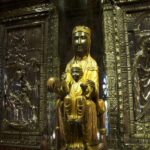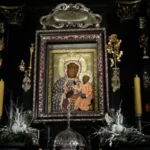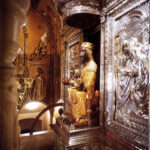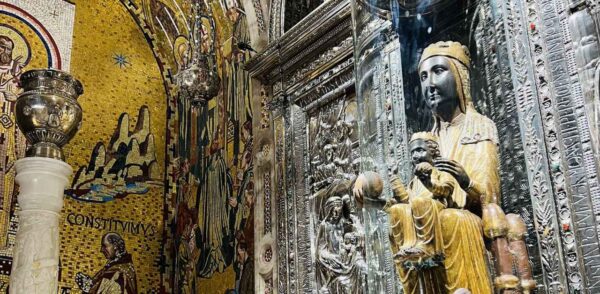
- The Historical Significance of the Black Lady of Montserrat
- Exploring the Origins of the Black Madonna: A Cultural Context
- Unraveling the Mysteries: The Legend of the Black Lady of Montserrat
- The Symbolism Behind the Black Lady: Colors and Meanings
- Pilgrimages to Montserrat: Spiritual Connections to the Black Madonna
- The Influence of the Black Lady on Art and Literature
The Black Lady of Montserrat, also known as La Moreneta, is a revered icon that captivates the hearts and minds of many. Nestled in the mountains of Catalonia, this statue transcends mere artistry, representing a rich tapestry of history, faith, and legend that continues to intrigue believers and historians alike.
In exploring The Mystique Behind the Black Lady of Montserrat: Unraveling the Enigma, we delve into the origins, cultural significance, and the myriad stories that surround this enigmatic figure. As a symbol of hope and unity, the Black Lady's allure stretches beyond geography, inviting a deeper understanding of her impact on spirituality and heritage.
The Historical Significance of the Black Lady of Montserrat
The historical significance of the Black Lady of Montserrat extends beyond her artistic representation; she embodies a profound cultural legacy that has shaped the spiritual landscape of Catalonia. Since her discovery in the 9th century, the statue has been a focal point for pilgrimage, drawing countless visitors who seek her intercession and guidance. The intertwining of faith and history makes her a symbol of resilience for the Catalan people, particularly during periods of political strife and social upheaval.
Throughout the centuries, La Moreneta has been linked to various significant events that underline her importance in Catalan history. For instance, during the Spanish Civil War, her sanctuary served as a refuge for those fleeing persecution. This association has transformed her into a beacon of hope for many, reinforcing the idea that faith can provide solace amidst turmoil.
Moreover, the Black Lady's iconography reflects the rich tapestry of multicultural influences that have permeated Catalonia. Her dark complexion and regal demeanor suggest a blend of Christian, Iberian, and African elements, showcasing the region's diverse historical interactions. This unique representation has inspired a range of artistic interpretations, making her a celebrated figure in both religious and cultural contexts.
- Pilgrimage Tradition: With an estimated 1.5 million visitors annually, the pilgrimage to Montserrat is one of the most significant in Spain.
- Symbol of Catalan Identity: The Black Lady has become an emblem of Catalonia's distinct cultural heritage, often invoked in times of national pride.
- Artistic Influence: Numerous artists, composers, and writers have found inspiration in the figure of La Moreneta, reflecting her lasting impact on the arts.
Exploring the Origins of the Black Madonna: A Cultural Context
The origins of the Black Madonna, or La Moreneta, are steeped in a blend of mythology, faith, and cultural evolution. While her history can be traced back to the early medieval period, the influences that shaped her image reflect a confluence of diverse traditions. Many believe that the statue embodies elements from pre-Christian Iberian worship, suggesting that her presence is a syncretic representation of both indigenous and Christian beliefs.
Across various cultures, the concept of a dark-skinned Madonna is not unique to Montserrat. This archetype is found in several regions, often symbolizing fertility, protection, and maternal love. The widespread veneration of Black Madonnas can be linked to the following factors:
- Cultural Integration: The blending of indigenous religions and emerging Christian practices.
- Symbolic Resonance: The dark complexion often represents the earth's fertility and the universality of motherhood.
- Historical Context: Many Black Madonnas emerged during periods of social upheaval, often serving as symbols of hope.
In the case of La Moreneta, her origins are further enriched by the historical context of Catalonia. The region has a long history of cultural exchanges with various civilizations, including the Moors and the Romans, which may have influenced her portrayal. As such, she serves not just as a religious icon but also as a manifestation of Catalonia’s complex identity, reflecting a harmonious blend of different cultural narratives.
Ultimately, the Black Madonna stands as a testament to the resilience of faith, embodying the shared stories of those who have sought her intercession throughout the centuries. As a deeply rooted figure within both the spiritual and cultural realms, she continues to inspire a sense of belonging and unity among her devotees, reminding them of their rich heritage and the power of their collective history.
Unraveling the Mysteries: The Legend of the Black Lady of Montserrat
The legend of the Black Lady of Montserrat, or La Moreneta, encompasses a rich array of mysteries that have fascinated believers for centuries. Her enigmatic origins are often linked to local folklore, which intertwines elements of divine intervention and miraculous appearances. Many claim that her statue was discovered by shepherds, solidifying her role as a protector and guide for the faithful.
One aspect that deepens the intrigue is the symbolism associated with her figure. The Black Lady is often seen as a unifying force, merging various cultural narratives into one potent symbol of hope. This multifaceted identity arises from diverse influences, including:
- Pre-Christian Traditions: Possible connections to ancient Iberian goddess worship.
- Historical Pilgrimages: Her sanctuary has been a pilgrimage site since the 9th century, fostering a rich tapestry of stories.
- Artistic Interpretations: Numerous works inspired by La Moreneta reflect her complex identity across cultures.
The allure of the Black Lady also lies in her connection to the broader phenomenon of Black Madonnas throughout Europe. These figures symbolize themes such as fertility, protection, and the universality of motherhood. The presence of such archetypes speaks to the shared human experience and the deep-rooted need for spiritual connection across diverse cultures.
As the Black Lady of Montserrat continues to inspire awe, her story invites exploration into the confluence of faith and culture. The ongoing pilgrimage tradition not only reaffirms her significance but also serves as a reminder of the enduring power of belief in shaping identities across generations. The mysteries surrounding her existence prompt us to reflect on our own journeys and the narratives that bind us to our heritage.
The Symbolism Behind the Black Lady: Colors and Meanings
The colors associated with the Black Lady of Montserrat, or La Moreneta, carry profound symbolism that resonates deeply within the cultural and spiritual landscape of Catalonia. Her dark complexion represents not only her identity but also signifies fertility, protection, and a deep connection to the earth. This portrayal challenges conventional representations of divinity, inviting a broader understanding of spirituality that encompasses diverse backgrounds and experiences.
Moreover, the contrasting elements in her iconography further amplify her significance. The rich tones of her robe, often depicted in hues of blue and gold, symbolize divine royalty and spiritual abundance. Each color serves as a reminder of the multifaceted nature of faith, where hope, love, and resilience intertwine. This intricate layering of colors invites believers to explore their own journeys through the lens of cultural heritage.
- Black: Represents the earth, fertility, and the strength of maternal figures.
- Blue: Symbolizes the divine, peace, and tranquility, often associated with the heavens.
- Gold: Signifies wealth, glory, and the light of divine presence.
As such, the Black Lady of Montserrat embodies a rich tapestry of meanings that invite both reverence and introspection. Her colors not only enhance her physical presence but also serve as a bridge connecting diverse cultural narratives, making her a profound symbol for those seeking solace, strength, and understanding in their faith.
Pilgrimages to Montserrat: Spiritual Connections to the Black Madonna
Pilgrimages to Montserrat hold a profound significance for many believers, serving as a transformative journey that reinforces their spiritual connections to the Black Madonna. Each year, millions embark on this sacred trek, seeking solace, healing, and guidance from La Moreneta. The pilgrimage is not merely a physical journey; it embodies a deep sense of purpose and devotion, allowing individuals to reflect on their faith and personal struggles.
Visitors often engage in various rituals upon reaching the sanctuary, such as lighting candles, offering prayers, and participating in communal worship. These spiritual practices foster a sense of unity among pilgrims, as they share their hopes and tribulations while honoring the Black Lady. The communal aspect of the pilgrimage transforms the experience into a collective expression of faith that transcends individual beliefs.
Moreover, the landscape surrounding Montserrat adds to the spiritual ambiance of the pilgrimage. The breathtaking natural beauty of the mountains serves as a reminder of the divine presence in the world, encouraging pilgrims to contemplate their connection to nature and spirituality. The act of climbing to the sanctuary symbolizes the ascent to a higher state of being, where the faithful can encounter the divine in a personal and impactful way.
In conclusion, the pilgrimage to Montserrat is a deeply rooted tradition that reflects the enduring spiritual connections to the Black Madonna. By participating in this revered journey, individuals not only seek divine intercession but also find an opportunity to connect with their cultural heritage and the collective story of faith that binds them to one another and to the beloved figure of La Moreneta.
The Influence of the Black Lady on Art and Literature
The influence of the Black Lady of Montserrat extends far beyond her role as a religious icon, inspiring a rich legacy in both art and literature. Artists have drawn upon her image to explore themes of faith, identity, and resilience. From sculptures to paintings, her representation often evokes a sense of wonder and reverence, reflecting the profound emotional connections that devotees have with her. Notable artistic expressions include:
- Paintings: Artists such as José de Ribera and Francisco de Goya have depicted the Black Lady, capturing her enigmatic presence.
- Sculptures: Contemporary artists have created installations that pay homage to her cultural significance.
- Literature: The Black Lady has inspired numerous poems, novels, and essays, weaving her narrative into the broader tapestry of Catalan literature.
In literature, the Black Lady serves as a powerful symbol and a muse for writers who grapple with themes of spirituality and cultural identity. Her story has been interpreted in various ways, often reflecting the struggles and triumphs of the Catalan people. Authors frequently explore the duality of her nature—both a nurturing mother and a fierce protector—which resonates deeply with those who seek solace and strength in her legend. Prominent literary references include:
- Poetic Works: Poets have utilized her image to articulate their spiritual journeys and connection to the divine.
- Historical Novels: Writers often incorporate La Moreneta into fictional narratives, emphasizing her role in Catalan history.
- Essays: Scholars analyze her influence, examining how she reflects broader societal values and struggles.
Moreover, the Black Lady's impact on art and literature underscores her role as a catalyst for cultural dialogue. Her presence provokes discussions around heritage, faith, and identity, inviting artists and writers to engage with the complexities of their shared history. The continual reinterpretation of her image serves not only to keep her story alive but also to foster a deeper understanding of the intertwined narratives that shape Catalan culture. This dynamic relationship illustrates how the Black Lady of Montserrat remains a vital source of inspiration across creative mediums.
 Why Should I Go to Montserrat? Discover the Enchanting Beauty of Barcelona's Majestic Mountain
Why Should I Go to Montserrat? Discover the Enchanting Beauty of Barcelona's Majestic Mountain Transportation in Barcelona
Transportation in Barcelona Interactive Barcelona Map - Explore Barcelona City Plan
Interactive Barcelona Map - Explore Barcelona City Plan The Enigma of the Black Madonna in Montserrat: Unraveling its Age
The Enigma of the Black Madonna in Montserrat: Unraveling its Age Unraveling the Mystery: Do You Have to Pay to See the Black Madonna?
Unraveling the Mystery: Do You Have to Pay to See the Black Madonna? The Enigmatic Black Madonna: Unveiling the Secrets Inside Montserrat Monastery
The Enigmatic Black Madonna: Unveiling the Secrets Inside Montserrat MonasteryIf you want to know other articles similar to The Mystique Behind the Black Lady of Montserrat: Unraveling the Enigma you can visit the category WHERE YOU CAN GO.
Deja una respuesta










Read more!